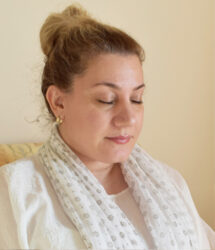Mother in Law: TM and Elder Care

I’m no spring chicken but compared to my mother-in-law who is 99, and barring unwelcome surprises, I’ve got a long way to go.
I’ve enjoyed a life virtually free from disease and filled with adventure and productivity. I’ve lived on two continents. I’ve worked as a teacher, attorney’s assistant, retail saleswoman, bi-lingual secretary at the UN, office manager, and director of planning at a university.
I’m in a pretty traditional marriage—most of the household chores fall to me. And though I haven’t raised children of my own, I have a lot of nieces and nephews I’ve cared for. I’ve always had the energy and stamina to do what was needed, usually with good cheer. I attribute much of this to my practice of the Transcendental Meditation technique, which renews me and boosts my capacity each time I do it. Even after a chaotic day, I have found that my afternoon TM session fully calms and re-charges me for the evening’s responsibilities. What is new to me—and somewhat of a shock in its intensity—is the responsibility of taking care of a spirited elderly woman.
Like every segment of society, seniors are a population that has specific unique issues. In general, older people have increased health problems. They don’t bounce back from illness or surgery as quickly as younger people. They may have cognitive problems, sometimes intermittent and unpredictable, and need help with doctors’ appointments, prescriptions and insurance issues. If they become frail or incapacitated in some way, they need physical assistance for basic everyday tasks.
Studies indicate that, as one ages, one is likely have some or many of these twelve symptoms:
- Increased insomnia
- High blood pressure
- Slower recovery time
- Slower reaction time
- Greater susceptibility to stress
- Higher cholesterol
- Reduced visual and auditory clarity
- Increased behavioral rigidity
- Increased depression and lower self-evaluation
- Decreased creativity
- Decreased memory
- Increased health care costs and hospitalization
My mother-in-law, bless her heart, learned the TM technique forty years ago. Into her nineties, she was able to drive, paint, read, cook, take excursions into the nearest city to museums and restaurants, and actively participate in the lives of her grandchildren. My husband and I credit much of her longevity and continued health and well-being to the benefits of TM. Consider, for instance:
- According to a 2013 scientific statement by the American Heart Association, the TM technique is the only meditation practice that has been shown by sufficient research data to lower blood pressure and may be considered in clinical practice for the prevention and treatment of hypertension. This benefit is associated with a 48 percent reduction in rates of death, heart attack, and stroke.
- Published research shows that just one year of regular TM practice can be the antidote to stress and its detrimental effects. The studies show that short term practitioners have, on average, a biological age five years younger than their chronological age. And five years of regular daily TM practice results in a biological age 12.5 years less than the meditator’s chronological age.
- Through our life, as stress accumulates, it has a deleterious effect on our whole physiology and notably on the brain. Repeated stress reduces the efficient functioning of the pre-frontal cortex, also known as the CEO of the brain. TM enlivens the function of the pre-frontal cortex so the meditator experiences more organized thinking and better decision-making ability.
- The AMA’s journal Archives of Internal Medicine published a study showing that the TM technique is highly effective in preventing the risk factors for high blood pressure, diabetes, and obesity.
- A study published in the Journal of Psychosomatic Medicine showed that TM practitioners consistently averaged less than half the hospitalization rates of non-practitioners in all disease categories.
We also noticed that when Mother became distressed or confused, she could resort to closing her eyes and doing Transcendental Meditation. Immediately she would experience deep relaxation and afterward be back on an even keel. Tension would disappear from her posture and face.
For these reasons, many people—later in life than one would suspect—do accept the help that TM can give. My friend’s father has meditated regularly since the early 1970s and now, at the age of 96, is still healthy, in good humor, and drives his car! Inspired by his example, some other seniors in the community where he lives recently asked to be instructed in Transcendental Meditation. One said her pain decreased in the first few days of practice. And another said she experienced peace that had eluded her all her life.
Without describing the almost-sitcom level of antics that pervade our household, suffice it to say that the way my mother-in-law and I survive and thrive is very much due to the blessings of Transcendental Meditation.
About the Author
Lesley Goldman is the retired director of a non-profit educational organization.





